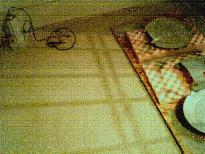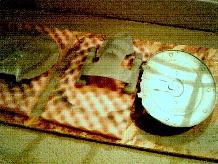|
I went to the local RadioShack.Com store and
purchased the remaining LEDs. I made the purchases based on size and
required luminescence, not consistency of voltage and current. The circuit
board is going to be pretty complicated.
 |
I got some canned air for the airbrush and
painted with enamel for the first time today. There are many benefits I'll
get to in a sec, but lemme tell you enamels are some high maintenance paints!
-
You can't have enough drop cloths, paper towels, etcetera for all the
drips
-
The fumes will knock you for a loop - use enamels outside
-
Enamels need to be thinned - being thinner, they flow smoother, and
hence a little container is gone before you know it.
-
I need to do some serious research into cleanup - my kitchen sink
needs attention....
|
Above all, however:
There remain sufficient benefits for
me to keep using enamels. To name a few:
- They are thinner and smoother, hence the application is much
nicer - it's easier to get a perfect consistency across a surface
- Base coat is not required - enamels bind to the plastic. I need
to research and confirm this, but it seems to be the case
- Personally, I think the colors are sharper and more accurate. I
like them more.
| You can do incredible things with the metallic
enamel paint! I wanted to use an aluminum metallic paint for the
inside of the hull because I wanted the light from the LEDs to be
efficient in their coverage of the area. I understood that it can be
buffed into a shine - boy, can it ever! If you look at the picture
at right (both this and the above were taken at night) you'll see the
saucer on the right is much shinier then the other parts - that's
why. You get a good coat of aluminum paint on it, let it dry, and
really buff that up with soft cotton and blow away what pieces are left
with canned air, and you get a highly reflective surface as a
result. I intend to use this technique all over the ship, inside the
warp nacelles, engineering section and saucer section. |
 |
There is another wonderful trick I discovered
quite by accident. After buffing the aluminum paint my fingers were quite
shiny with particulate. I didn't think about it as I handled the rest of
the model pieces (don't forget, we are dealing with the Enterprise-D model
here!) and after a while I noticed something that looked like texture on the
surface. I assumed it was the base coat, but found that the piece that I
didn't put a base on had it, too (and looked a little more refined, I might
add). I discovered that if I put a fine amount of this metallic
particulate over the paint job, it adds quite a different hue to the whole
thing. By fine, I mean I quickly took the same cloth I buffed the inside
of the saucer with and ran it over the outer hull, then hit it with the canned
air again. I really like the effect - it gives it a less 'sterile'
appearance and makes it look like, well, metal.
I also discovered I need to mess with the primary
hull color - the kit recommends Light Ghost Grey, but it doesn't look
right. The original designer recommended Deckhouse Blue (hard to find),
and another said he used a variant of Duck Egg Blue.
Electrical notes:
Working on the locations of the LEDs, voltages,
etc. in preparation for final circuit creation and initial identification of
placement. I played with the brightness values in relation to each other
and what I expect the general hue of the ship to be . My notes:
ohms=volts/amps
port
indicators (red)
v=1.8
i=.05
min. resistance : 36 ohms
preferred resistance : 330 ohms
starboard
indicators (green)
v=1.8
i=.032
min. resistance : 56.25 ohms
preferred resistance : 470 ohms (to keep same luminescance as red)
bussard
collectors:
1 small red LED, pt 8700
v=3
i=.05
min resistance : 60 ohms
preferred resistance : 470 ohms
small piece of mylar coating bottom and top, shining LED directly into it
and down will prevent light leakage. Align
LED so
that
it begins to shine where the transparent plastic begins (allowing different
intensities into plastic).
warp
nacelles:
2 small blue LEDs per nacelle, pt 8005
v=3
i=.2
min resistance : 15 ohms
preferred resistance : 330 ohms
mylar lining top and bottom of nacelle (also shielding bussard area),
each LED pointing towards the other, and down.
white
LEDs (all windows, flashing running lights)
v = 3
i = .20
min resistance : 15 ohms
preferred resistance - 20 ohms
place mylar beneath each LED to prevent leakage.
One LED per two windows, from across the hull. Onion skin paper over each.
window.
deflector
dish - (blue, pt. 276-316)
v-3
i=.20
min. resistance : 15 ohms
preferred resistance : 20 ohms
Pass light through onion skin paper to diffuse on the way to the main
deflector. paint on main deflector
should be thin.
Ensure
all cracks and any possible source of light leakage is sealed in hull
construction due to internal mirroring.
|

